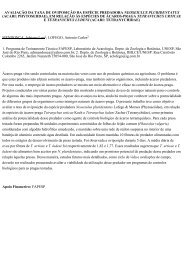Aplicação de feromônios no manejo de pragas em fruteiras de clima ...
Aplicação de feromônios no manejo de pragas em fruteiras de clima ...
Aplicação de feromônios no manejo de pragas em fruteiras de clima ...
Create successful ePaper yourself
Turn your PDF publications into a flip-book with our unique Google optimized e-Paper software.
HUMBER, Richard A.<br />
WHAT'S THE DEAL WITH THE ENTOMOPHTHORALES<br />
USDA-ARS Biological IPM Research Unit, RW Holley Center for Agriculture and Health,<br />
Tower Road, Ithaca, NY 14753, USA. Email: richard.humber@ars.usda.gov<br />
Extensive recent phylogenetic analyses of sequences from multiple genes for an extraordinarily<br />
large and comprehensive sampling of all fungal groups have resulted in a new classification of<br />
fungi. This new classification overturns many old and familiar concepts but also facilitates new<br />
research on the biology and potential applications of these fungi. The chytrid fungi (with<br />
posteriorly uniflagellate zoospores) are <strong>no</strong>w divi<strong>de</strong>d among three phyla (Chytridiomycota,<br />
Blastocladiomycota, and Neocallimastigomycota). The most basal groups among the<br />
<strong>no</strong>nflagellate fungi <strong>no</strong>w inclu<strong>de</strong> the Microsporidia as well as the fungi formerly classified as<br />
Zygomycota. The complete transformation of the new (but still only partially resolved)<br />
classification for these zygomycete fungi raises some unusual phylogenetic questions<br />
<strong>de</strong>manding many more <strong>de</strong>tailed studies of these fungi. The new classification of these basal (or<br />
ancestral) <strong>no</strong>nflagellate fungi is reviewed briefly in this presentation, with a major <strong>em</strong>phasis is<br />
on the Entomophthorales, the or<strong>de</strong>r that contains the vast majority of zygomycete<br />
entomopathogens and that (still!) raise some very perplexing questions and controversies. The<br />
Entomophthorales, which may or may <strong>no</strong>t be a mo<strong>no</strong>phyletic ass<strong>em</strong>blage, certainly inclu<strong>de</strong>s<br />
some of the most ancestral of all <strong>no</strong>nflagellate fungi. Quite apart from their amazingly diverse<br />
biological capacities, entomophthoralean fungi occupy a fundamentally important evolutionary<br />
position at the interface where some chytrid (or, most realistically, some blastocladian)<br />
watermold lost its flagellum and gave rise to the r<strong>em</strong>ain<strong>de</strong>r of the zygomycetes, to the<br />
arbuscular mycorrhizal fungi, and the ‘higher’ fungi in the phyla Ascomycota and<br />
Basidiomycota.<br />
Palavras-chave: Entomophthorales, Basidiobolus, taxo<strong>no</strong>my, entomopathogenic fungi






